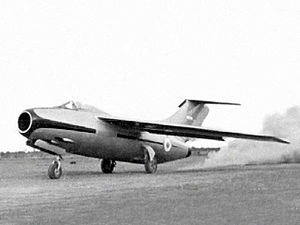| IAe 33 Pulqui II | |
|---|---|
 Pulqui II (No. 02) c. 1950 | |
| General information | |
| Type | Fighter/Interceptor |
| Manufacturer | Fábrica Militar de Aviones |
| Designer | |
| Status | Cancelled |
| Primary user | Argentine Air Force |
| Number built | 1 static prototype + 4 flying prototypes |
| History | |
| First flight | 27 June 1950[2] |
The FMA IAe 33 Pulqui II (in the indigenous language Mapuche, Pulqúi: Arrow)[3] was a jet fighter aircraft designed by Kurt Tank in the late 1940s in Argentina, under the Perón government, and built by the Fábrica Militar de Aviones (FMA).[4] Embodying many of the design elements of the wartime Focke-Wulf Ta 183, an unrealized fighter project,[5] the FMA envisioned the IAe 33 Pulqui II as a successor to the postwar Gloster Meteor F4 in service with the Fuerza Aérea Argentina. The Pulqui II's development was comparatively problematic and lengthy, with two of the four prototypes being lost in fatal crashes. Despite one of the prototypes being successfully tested in combat during the 1955 Revolución Libertadora, the political, economic and technical challenges faced by the project meant that the IAe 33 was unable to reach its full potential, and the Argentine government ultimately chose to purchase F-86 Sabres from the United States in lieu of continuing development of the indigenous fighter to production status.[6]


- ^ a b "Bienes de Interés Históricos Nacionales".
- ^ Cite error: The named reference
Paul p. 145was invoked but never defined (see the help page). - ^ Crowder-Taraborrelli, Tomas F. "Evita in Wonderland: Pulqui and the Workshop of Underdevelopment". CineAction, 22 June 2009. Retrieved 26 April 2010.
- ^ Green and Pollinger 1955, p. 105.
- ^ Meyer 2007, p. 98.
- ^ Green 1979, p. 304.
- ^ Swan, Matt. "Tamiya (ex AM-Tech) 1/48 Ta.183A 'Huckebein'". swannysmodels.com. Retrieved 10 May 2010.